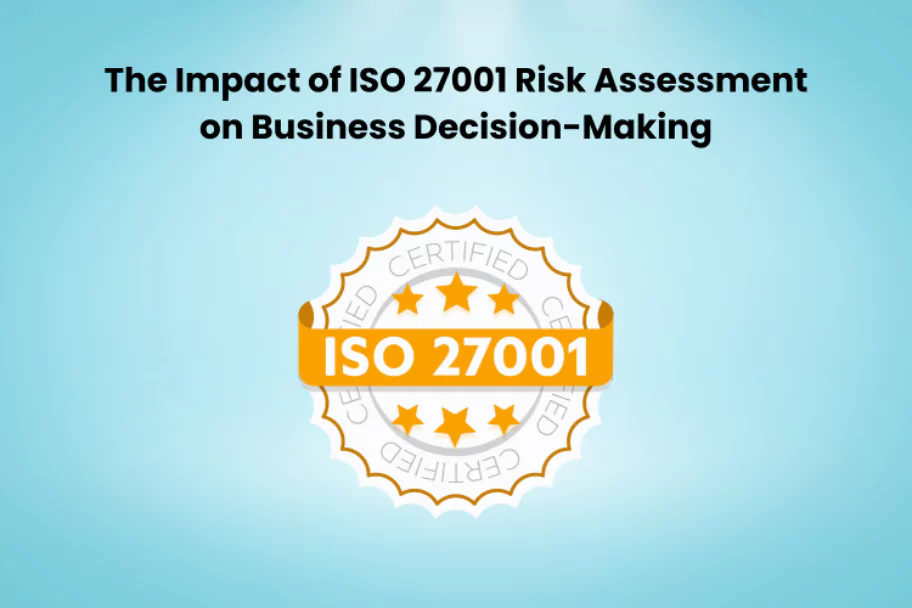ISO 27001 Certification is a globally recognized standard for information security management systems (ISMS) that provides a framework for organizations to manage and protect their sensitive information. A crucial component of ISO 27001 Risk Assessment process, which helps organizations identify, evaluate, and prioritize information security risks. In this blog, we will explore the impact of ISO 27001 risk assessment on business decision-making and how organizations can leverage this process to enhance their overall security posture and strategic decision-making.
Understanding ISO 27001 Risk Assessment
The systematic process of discovering, assessing, and evaluating information security threats to the organization is known as ISO 27001 risk assessment. The purpose of the risk assessment process is to identify possible threats to information assets, evaluate the possibility and potential consequences of such threats, and ascertain the organization’s degree of risk exposure. After that, a risk treatment strategy is created using this data, outlining how the company will reduce, transfer, or accept risks that have been identified.
Impact of ISO 27001 Risk Assessment on Business Decision-Making
- Informed Risk Management: Organisations may make well-informed choices about how to successfully manage information security risks by using the complete knowledge of information security risks that the ISO 27001 risk assessment gives them. Organizations may ensure that their risk management efforts are focused and successful by prioritizing their efforts and allocating resources to areas with the greatest risk by identifying and evaluating risks.
- Strategic Planning: Organisations may better align their information security policies with their overarching business goals by using the insights obtained from ISO 27001 risk assessment to guide their strategic planning activities. Organizations may ensure that their business plans are robust to security risks by developing strategies that include possible security threats and vulnerabilities based on their knowledge of their risk profile.
- Compliance and Regulatory Requirements: Organisations may guarantee compliance with industry standards and regulatory requirements by using ISO 27001 risk assessment. Organizations may prevent expensive fines and harm to their reputation caused by neglecting to fulfill regulatory requirements by anticipating and proactively recognizing any non-compliance concerns.
- Resource Allocation: By concentrating on areas with the most risk, ISO 27001 risk assessment enables organizations to allocate resources efficiently. This guarantees that resources are allocated to minimizing the most serious security risks, boosting the return on security expenditures, and maximizing resource efficiency.
- Enhanced Stakeholder Confidence: Demonstrating a robust risk assessment process through ISO 27001 certification can enhance stakeholder confidence in an organization’s ability to manage information security risks effectively. For businesses handling sensitive consumer data or under regulatory inspection, this might be especially crucial.
Leveraging ISO 27001 Risk Assessment for Business Success
The following recommended practices should be taken into consideration by organizations in order to maximize the influence of ISO 27001 risk assessment on business decision-making:
- Integrate Risk Management into Business Processes: To ensure that the results of risk assessments are considered when making decisions across the company, including risk management procedures into business processes.
- Regularly Review and Update Risk Assessments: Conduct regular reviews of risk assessments to ensure that they remain relevant and aligned with the organization’s evolving risk landscape.
- Engage Stakeholders: Engage stakeholders across the organization in the risk assessment process to ensure that a broad range of perspectives is considered, and decisions are well-informed.
- Effectively Communicate Risk Findings: To support well-informed decision-making, clearly and succinctly convey risk assessment results to key decision-makers.
- Continuously Improve Risk Management Practices: Continuously monitor and improve risk management practices based on lessons learned and changes in the organization’s environment to ensure that they remain effective.
Conclusion
By leveraging ISO 27001 risk assessment for business decision-making, organizations can strengthen their information security practices, enhance strategic planning efforts, and demonstrate commitment to managing information security risks effectively. This proactive approach not only fosters better stakeholder confidence and improves business results but also provides a competitive edge in the marketplace. Investing in IT Security & Data Protection Courses can further fortify these efforts, ensuring a well-rounded and up-to-date approach to safeguarding sensitive information.




